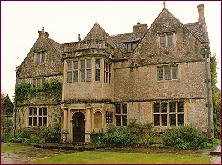
St Catherine's Court is a manor house in a secluded valley north of Bath, Somerset, England. It is a Grade I listed property. The gardens are Grade II* listed on the Register of Historic Parks and Gardens of special historic interest in England.

Maristow House in the parish of Bickleigh, Devon, England, is a large country house set in landscaped parkland, on the River Tavy to the north of Plymouth. It was built in about 1560, rebuilt in the mid-18th century and further remodelled in the early 20th century. Between 1798 and 1938 it was the residence of the Lopes family, Barons Roborough. The house was ruined by fire after World War II, but was restored and converted into apartments in the late 1990s by Kit Martin. It is a grade II* listed building, having been so designated on 29 March 1960.
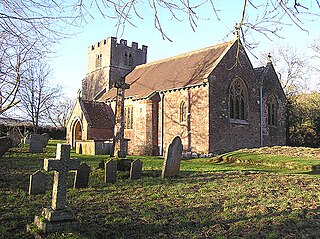
Tolland is a village and civil parish in Somerset, England, situated 9 miles (14.5 km) north west of Taunton, between the Brendon Hills and Quantock Hills. The parish has a population of 81.

Oakwell Hall is an Elizabethan manor house in Birstall, West Yorkshire, England. The Grade I listed hall is set in period gardens surrounded by 110 acres (0.45 km2) of country park.

Lytes Cary is a manor house with associated chapel and gardens near Charlton Mackrell and Somerton in Somerset, England. The property, owned by the National Trust, has parts dating to the 14th century, with other sections dating to the 15th, 16th, 18th, and 20th centuries. "Yet all parts blend to perfection with one another and with the gentle sunny landscape that surrounds them," comments Nikolaus Pevsner. The House is listed as Grade I by English Heritage.

Belmont Hall is a country house one mile (1.6 km) to the northwest of the village of Great Budworth, Cheshire, England. It is recorded in the National Heritage List for England as a designated Grade I listed building. The house stands to the north of the A559 road. Since 1977 it has been occupied by Cransley School.

Frascati is an early 19th-century Federal-style plantation house near Somerset in Orange County, Virginia. Frascati was the residence of Philip P. Barbour, Associate Justice of the Supreme Court of the United States and statesman.

Nailsea Court in Nailsea, Somerset, England, is an English manor house dating from the 15th century. Pevsner describes the house as "historically highly instructive and interesting" and it is a Grade I listed building.

The Court House in East Quantoxhead, Somerset, England has a medieval tower and other parts of the building which date from the 17th century. It has been designated as a Grade I listed building.

The Manor House in West Coker, Somerset, England has medieval origins, however the earliest surviving portions of the current building probably date from around 1500. It has been designated as a Grade I listed building.

The Gerard Crane House is a private home located on Somerstown Turnpike opposite Old Croton Falls Road in Somers, New York, United States. It is a stone house dating to the mid-19th century, built by an early circus entrepreneur in his later years.

Virginia House is a manor house on a hillside overlooking the James River in the Windsor Farms neighborhood of Richmond, Virginia, United States.

Over Langford Manor, also known as The Old Courthouse is a Grade II listed building, in Upper Langford, North Somerset, England.
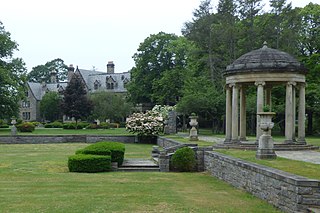
Lillian Sefton Dodge Estate, also known as Sefton Manor and Mill Neck Manor Lutheran School for the Deaf, is a historic estate located at Mill Neck in Nassau County, New York. It has 34 rooms and is 60,000 square feet.
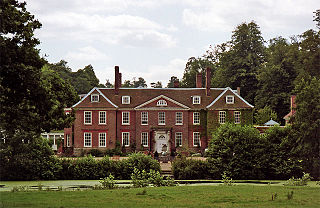
Chilston Park is a country house in Boughton Malherbe, Kent, England. Started in the 15th century, the house has been modified many times and is a Grade I listed building, currently operated as a country house hotel.
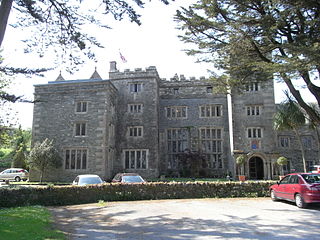
Boringdon Hall is a 16th-century Grade I listed manor house in the parish of Colebrook, about two miles north of Plympton, Devon.
Urchinwood Manor is a Grade II* listed building at Congresbury within the English county of Somerset.

Temora Post Office is a heritage-listed post office at 173 Hoskins Street, Temora, New South Wales, Australia. It was added to the Australian Commonwealth Heritage List on 8 November 2011.
John Papworth (1750–1799) was an eminent plasterer and stuccoist working in London in the late 18th century.

Leonard Shuffrey was a British architect and architectural designer of the late Victorian and Edwardian period. He was a leading figure of the aesthetic movement that had a significant impact on the development of buildings and their interiors and their settings, both across London and the South of England. Noted for his wallpaper, fireplaces and ornate plasterwork, Shuffrey was thought the equal of William Morris in his creativity and skill as a craftsman. His output is often found in decorative schemes with William Morris, Edward Ould, William De Morgan, and other preeminent Arts & Crafts and late Pre-Raphaelite decorative artists of the day.


















